*NURSING > TEST BANK > Environmental Health Stanhope: Public Health Nursing: Population-Centered Health Care in the Communi (All)
Environmental Health Stanhope: Public Health Nursing: Population-Centered Health Care in the Community, 10th Edition,100% CORRECT
Document Content and Description Below
Environmental Health Stanhope: Public Health Nursing: Population-Centered Health Care in the Community, 10th Edition MULTIPLE CHOICE 1. Why is it important for nurses to understand the premise... s of environmental health? a. Nurses should be able to assess risks and advocate for policies that support healthy environments. b. Toxicologists often consult nurses about environmental pollutants. c. Pollutant exposures such as lead are reported by nurses to the Environmental Protection Agency (EPA). d. Many Americans live in areas that do not meet current national air quality standards. ANS: A Potential risks to health are concerns for professional nurses. It is the responsibility of the nurse to understand as much as possible about these risks: how to assess them, how to eliminate/reduce them, how to communicate and educate about them, and how to advocate for policies that support healthy environments. Toxicologists do not often consult nurses about environmental pollutants. Pollutant exposures are not routinely reported by nurses. Although there may be problems with air quality standards in the United States, this would not be the primary reason why nurses should understand environmental health. DIF: Cognitive level: Understanding TOP: Nursing process: Evaluation MSC: NCLEX: Safe and ENfUfeRctSivIe NCaGreTEBn.vCiroOnMment: Safety and Infection Control 2. Why is it important for a nurse to have knowledge of environmental health and the effects of chemical, biological, and radiological materials? a. They are a major cause of global warming. b. They are often found in the air, water, and products we use. c. They are frequently linked to the development of chronic illnesses. d. They are products that nurses work with daily. ANS: B Chemical, biological, and radiological pollutants are often found in the air we breathe, the water we drink, and the products we use. These are not a major cause of global warming. They are not frequently linked to the development of chronic illnesses. These are not products that nurses work with daily. DIF: Cognitive level: Understanding TOP: Nursing process: Assessment MSC: NCLEX: Health Promotion and Maintenance 3. A nurse fulfills the environmental health competency of “assessment and referral.” Which of the following actions has the nurse most likely completed? a. Advocating for public policy changes b. Understanding policy framework and major pieces of legislation c. Completing an environmental health history d. Describing the scientific principles about environmental health ANS: C Assessment and referral states that all nurses should be able to successfully complete an environmental health history, recognize the potential environmental hazards and sentinel illnesses, and make appropriate referrals for conditions with probable environmental causes. Advocating for public policy changes is part of advocacy. Understanding policy framework and legislation is part of legislation and regulation. Describing the scientific principles of environmental health is part of basic knowledge and concepts. DIF: Cognitive level: Analyzing TOP: Nursing process: Implementation MSC: NCLEX: Safe and Effective Care Environment: Safety and Infection Control 4. How have nurses historically learned to identify a possible relationship between environmental chemical exposures and their potential harm? a. Extrapolation by toxicologists b. Biomonitoring c. Completing chemistry courses d. Observing signs and symptoms in clients ANS: D Nurses have historically made discoveries related to chemical exposure when people presented with signs and symptoms related to known chemical toxicity. Extrapolation by toxicologists and biomonitoring are modern methods. Completing a chemistry course does not show how to identify these possible relationships. DIF: Cognitive level: Understanding TOP: Nursing process: Assessment MSC: NCLEX: Safe and ENffeRctivIe CaGre EBn.vCironMment: Safety and Infection Control U S N T O 5. What term is used to refer to the basic science applied to understanding the health effects associated with chemical exposures? a. Toxicology b. Pharmacology c. Chemistry d. Environmental epidemiology ANS: A Toxicology is the study of the health effects associated with chemical exposures. Pharmacology is the branch of medicine concerned with the multiple aspects of drugs. Chemistry is the branch of science with deals with the way that matter is composed. Environmental epidemiology is concerned with the discovery of environmental exposures that cause or protect against illness or disease. DIF: Cognitive level: Remembering TOP: Nursing process: Assessment MSC: NCLEX: Safe and Effective Care Environment: Safety and Infection Control 6. What statement accurately describes the characteristics of epidemiology? a. It is a science that studies the poisonous effects of chemicals. b. It explains the association between learning disabilities and exposure to lead-based paint at the cellular level. c. It helps nurses understand the strength of the association between exposure and health effects. d. It is a method for tracking the prevalence of health outcomes. ANS: C Epidemiology studies the incidence and prevalence of disease, helping nurses understand the strength of the association between exposure and health effects. Toxicology is the science that studies the poisonous effects of chemicals. Environmental surveillance provides data with which to track and analyze the incidence and prevalence of health outcomes. Epidemiology does not examine causes at the cellular level. DIF: Cognitive level: Remembering TOP: Nursing process: Assessment MSC: NCLEX: Safe and Effective Care Environment: Management of Care 7. When researching pesticides, the nurse looks at the “family” of the chemical. What similarities are found among chemicals that have been placed in the same family? a. Route of entry into the body b. Actions and associated risks c. Effects that they have on the body d. Potency and toxicity ANS: B Chemicals are grouped so it’s possible to understand the actions and risks associated with each group. Although some common health risks exist within these families of chemicals, the possible health risks for each chemical should be evaluated individually when a potential human exposure exists. DIF: Cognitive level: ApNplyiRng I G B.TCOPM: Nursing process: Assessment MSC: NCLEX: Safe and EfUfectSive NCareTEnviroOnment: Safety and Infection Control 8. Which example contains the components necessary to form an epidemiologic triangle? a. Pesticides, water, food b. Lead, mercury, soil c. Trichloroethylene, water, infants d. Children under 12, elderly, temperature ANS: C The epidemiologic triangle consists of an agent (chemical), host (community consisting of several variants), and environment (air, water, soil, etc.). The other examples do not contain an agent, host, and environment. DIF: Cognitive level: Analyzing TOP: Nursing process: Evaluation MSC: NCLEX: Safe and Effective Care Environment: Safety and Infection Control 9. When would it be appropriate for a nurse to use a Geographic Information System (GIS)? a. Recording client data collected at a foot clinic b. Identifying areas with an increased incidence of lead poisoning c. Evaluating effectiveness of a farm safety program d. Scheduling health promotion programs in the community ANS: B The use of a GIS allows the PHN to apply the principles of epidemiology into practice. GIS allows nurses to code data so that it is related spatially to a place on earth and is helpful in determining concentrated areas for incidence of disease and illness. An electronic health record (EHR) would be the most appropriate place to record client data from a foot clinic. Evaluation of effectiveness of a farm safety program would need to be done through some type of assessment or evaluation method—GIS would not be useful to collect this data. GIS is not a scheduling system and would not be helpful when scheduling health promotion programs in the community. DIF: Cognitive level: Analyzing TOP: Nursing process: Implementation MSC: NCLEX: Safe and Effective Care Environment: Safety and Infection Control 10. A public health nurse (PHN) is organizing a multidisciplinary team to address the issue of water pollution in the community. Which group of professionals would be invited to address this issue? a. Physicians, water sanitation workers, and occupational therapists b. Pharmacologists, radiologists, and epidemiologists c. Nurse practitioners, pharmacologists, and environmentalists d. Geologists, meteorologists, and chemists ANS: D Scientists who study how pollutants travel in air, water, and soil are geologists, meteorologists, and chemists. The other professionals are not experts in the area of water pollution in the community. DIF: Cognitive level: Analyzing TOP: Nursing process: Implementation MSC: NCLEX: Safe and ENfUfeRctSivIe NCaGreTEBn.vCiroOnMment: Management of Care 11. A nurse would identify which as a point source of air pollution? a. A smoke stack b. The number of cars and trucks c. The amount of fossil fuel consumed in a community d. Ground ozone levels ANS: A Point sources of pollution are identifiable sources of air pollution, such as a smoke stack. Nonpoint sources come from more diffuse exposures, such as from cars and trucks. The amount of fossil fuel that is consumed and ground ozone levels do not identify sources of air pollution. DIF: Cognitive level: Applying TOP: Nursing process: Assessment MSC: NCLEX: Safe and Effective Care Environment: Safety and Infection Control 12. A nurse is completing an exposure history using the mnemonic I PREPARE. What data would a nurse collect when asking questions about the first “P”? a. Present work b. Potential exposures c. Personal protective equipment use d. Past work ANS: A Present work is the first “P.” Potential exposures are part of the “I”—investigate potential exposures. Personal protective equipment use is not part of the mnemonic. Past work is the second “P.” DIF: Cognitive level: Remembering TOP: Nursing process: Assessment MSC: NCLEX: Safe and Effective Care Environment: Safety and Infection Control 13. What is the greatest single source of air pollution in the United States? a. Waste incineration b. Power plants c. Motor vehicles d. Molds ANS: C Mobile sources such as cars and trucks are the greatest single source of air pollution in the United States. Waste incineration and power plants are major contributors after motor vehicles. Molds contribute to poor indoor air quality. DIF: Cognitive level: Remembering TOP: Nursing process: Assessment MSC: NCLEX: Safe and Effective Care Environment: Safety and Infection Control 14. A nurse wants to find more information about indoor air quality. Which of the following websites would be most helpful? a. The National Institutes of Health (NIH) b. The American Lung Association c. “Right to Know” NURSINGTB.COM d. The Occupational Safety and Health Administration (OSHA) ANS: B Indoor air quality is a growing public health concern in office buildings, schools, and homes and is reflected in the alarming rise in asthma incidence in the United States, particularly among children. Sources of information about indoor air quality include the EPA and the American Lung Association. The NIH is part of the U.S. Department of Health and Human Services (USDHHS) and is responsible for health and biomedical research. “Right to Know” is part of a workplace safety legislation. OSHA regulates safety in factories and businesses. DIF: Cognitive level: Applying TOP: Nursing process: Assessment MSC: NCLEX: Safe and Effective Care Environment: Safety and Infection Control 15. Employees working with hazardous chemicals have the “Right to Know” about the chemicals they are working with through the creation of which resource? a. Material Safety Data Sheet (MSDS) b. Consumer Confidence Report c. Hazard Communication Standard d. Environmental Protection Agency (EPA) ANS: C The Hazard Communication Standard requires employers to maintain a list of all hazardous chemicals that are used on site. Each of the chemicals should have an associated chemical information sheet known as an MSDS, which is written by the chemical manufacturer. Consumer Confidence Reports summarize the results of the annual testing of the public water supply. The EPA sets forth policies, regulations, and public laws for the safety of the environment and the population. DIF: Cognitive level: Understanding TOP: Nursing process: Assessment MSC: NCLEX: Safe and Effective Care Environment: Safety and Infection Control 16. What is considered a nonpoint source of pollution? a. Hazardous waste site b. Animal waste from wildlife c. Chlorine poured down a well d. Stagnant water ANS: B Nonpoint sources come from more diffuse exposures to pollution. Animal waste is the only diffuse exposure given. The others are considered point sources; point sources are individual, identifiable sources such as smoke stacks. DIF: Cognitive level: Applying TOP: Nursing process: Assessment MSC: NCLEX: Safe and Effective Care Environment: Safety and Infection Control 17. A nurse is completing the first phase of a risk assessment. Which of the following questions would the nurse most likely try to answer? a. Has the chemical been NreleRasedIintGo thBe .enCviroMnment? b. How much and by which route of entry can the chemical enter the body? c. Is the chemical known to be associated with a negative health effect? d. What is the prediction for potential harm? ANS: C The first phase is determining if a chemical is known to be associated with negative health effects (in animals or humans): Is the chemical known to be associated with a negative health effect? The second step is determining if the chemical has been released into the environment: Has the chemical been released into the environment? The third step is estimating how much and by which route of entry the chemical might enter the human body: How much and by which route of entry can the chemical enter the body? The final step considers the previous steps: What is the prediction for potential harm? DIF: Cognitive level: Analyzing TOP: Nursing process: Assessment MSC: NCLEX: Safe and Effective Care Environment: Safety and Infection Control 18. A nurse working at the individual level to reduce pollution in the environment would most likely be involved in what activity? a. Providing a tax incentive to factories that do not pollute b. Making laws related to allowed levels of pollution in the area c. Recycling paper, glass, cans, and plastic d. Moving to an area with less pollution ANS: C Nurses can reduce pollution by doing their part, which can include choosing to recycle paper, glass, cans, and plastic. Providing a tax incentive and creating laws would not be completed at the individual level to reduce pollution in the environment. Moving to an area with less pollution would not help to improve the problem. DIF: Cognitive level: Applying TOP: Nursing process: Implementation MSC: NCLEX: Safe and Effective Care Environment: Safety and Infection Control 19. What is the first step the nurse would take when addressing the problem of air pollution in the community? a. Setting standards b. Monitoring c. Permitting d. Compliance ANS: C Permitting is a process by which the government places limits on the amount of pollution emitted into the air or water. Environmental standards may describe a permitted level of emissions, a maximum containment level, an action level for environmental cleanup, or a risk-based calculation. Monitoring is an ongoing process after an action has happened. Compliance refers to the processes for ensuring that permit/standard/regulatory requirements are met. DIF: Cognitive level: Applying TOP: Nursing process: Implementation MSC: NCLEX: Safe and Effective Care Environment: Safety and Infection Control N R I G B.C M 20. A city sets the standard of an acceptable level of emissions or a maximum contaminant level allowed for factories. Which concept is being applied? a. Controlling pollution b. Waste minimization c. Land use planning d. Environmental standard ANS: D An example of an environmental standard is an acceptable level of emissions or a maximum contaminant level allowed. Although this does help to control pollution, environmental standard is best applied in this example. Setting a standard for emissions does not impact waste minimization or land use planning. DIF: Cognitive level: Applying TOP: Nursing process: Implementation MSC: NCLEX: Safe and Effective Care Environment: Safety and Infection Control 21. A facility is inspected after it has obtained a permit. The inspection is completed for the purpose of observing whether the plans submitted in the permit application are being implemented as approved. Which of the following environmental protection strategies is being applied? a. Controlling pollution b. Waste minimization c. Land use planning d. Environmental monitoring ANS: D Environmental monitoring would be an inspection of a facility after a permit is obtained to observe whether the plans submitted in the permit application are being implemented as approved. Permitting is an important step in controlling pollution. Waste minimization and land use planning are activities aimed at prevention of pollution. DIF: Cognitive level: Applying TOP: Nursing process: Implementation MSC: NCLEX: Safe and Effective Care Environment: Safety and Infection Control 22. Which environmental law sets basic structure for regulating pollutants to United States waters? a. Safe Drinking Water Act b. Toxic Substance Control Act c. Clean Water Act d. Pollution Prevention Act ANS: C The Clean Water Act sets basic structure for regulating pollutants to United States waters. The Safe Drinking Water Act authorized the EPA to establish safe standards of purity and required all owners or operators of public water systems to comply with primary standards. The Toxic Substance Control Act gives the EPA the ability to track the 75,000 industrial chemicals currently produced or imported into the United States. The Pollution Prevention Act focused industry, government, and public attention on reduction of the amount of pollution through cost-effective changes in production, operation, and use of raw materials. DIF: Cognitive level: ReNmUemRbSeIrinNgGTB.TCOOPM: Nursing process: Assessment MSC: NCLEX: Safe and Effective Care Environment: Safety and Infection Control MULTIPLE RESPONSE 1. A public health nurse (PHN) working with a family living in poverty is concerned about their exposure to environmental hazards. Which of the following factors should the nurse identify as possibly putting the family at risk? (Select all that apply.) a. Limited funds to pay for health care b. Poor nutrition c. Homes located closer to hazardous waste sites d. Less education e. Unsafe working conditions ANS: A, B, C Families living in poverty are more likely to experience environmental justice issues such as disproportionate environmental exposures. Substandard housing, living closer to hazardous waste sites, working in more hazardous jobs, poorer nutrition, and less access to quality health care all contribute to this issue. Although limited education is related to poverty, it is not discussed as causing an increase in environmental exposure. DIF: Cognitive level: Applying TOP: Nursing process: Implementation MSC: NCLEX: Safe and Effective Care Environment: Safety and Infection Control 2. A nurse is assessing for environmental health risks in the community. Which of the following approaches would be most appropriate for the nurse to use? (Select all that apply.) a. Asking legislators to provide a list of environmental pollutants in the area b. Developing a list of exposures associated with urban, rural, or suburban settings c. Assessing the risk by medium such as air, water, soil, or food d. Dividing the environment into functional locations: home, school, workplace, and community e. Recruiting community members to sign a petition to decrease pollution ANS: B, C, D Developing a list of exposures associated with urban, rural, or suburban settings, assessing the risk by medium such as air, water, soil, or food, and dividing the environment into functional locations: home, school, workplace, and community are ways a nurse can assess the environment. Asking legislators for a list of pollutants or recruiting community members to sign a petition are not effective means to assess for environmental health risks. DIF: Cognitive level: Applying TOP: Nursing process: Implementation MSC: NCLEX: Safe and Effective Care Environment: Safety and Infection Control NURSINGTB.COM [Show More]
Last updated: 11 months ago
Preview 1 out of 17 pages
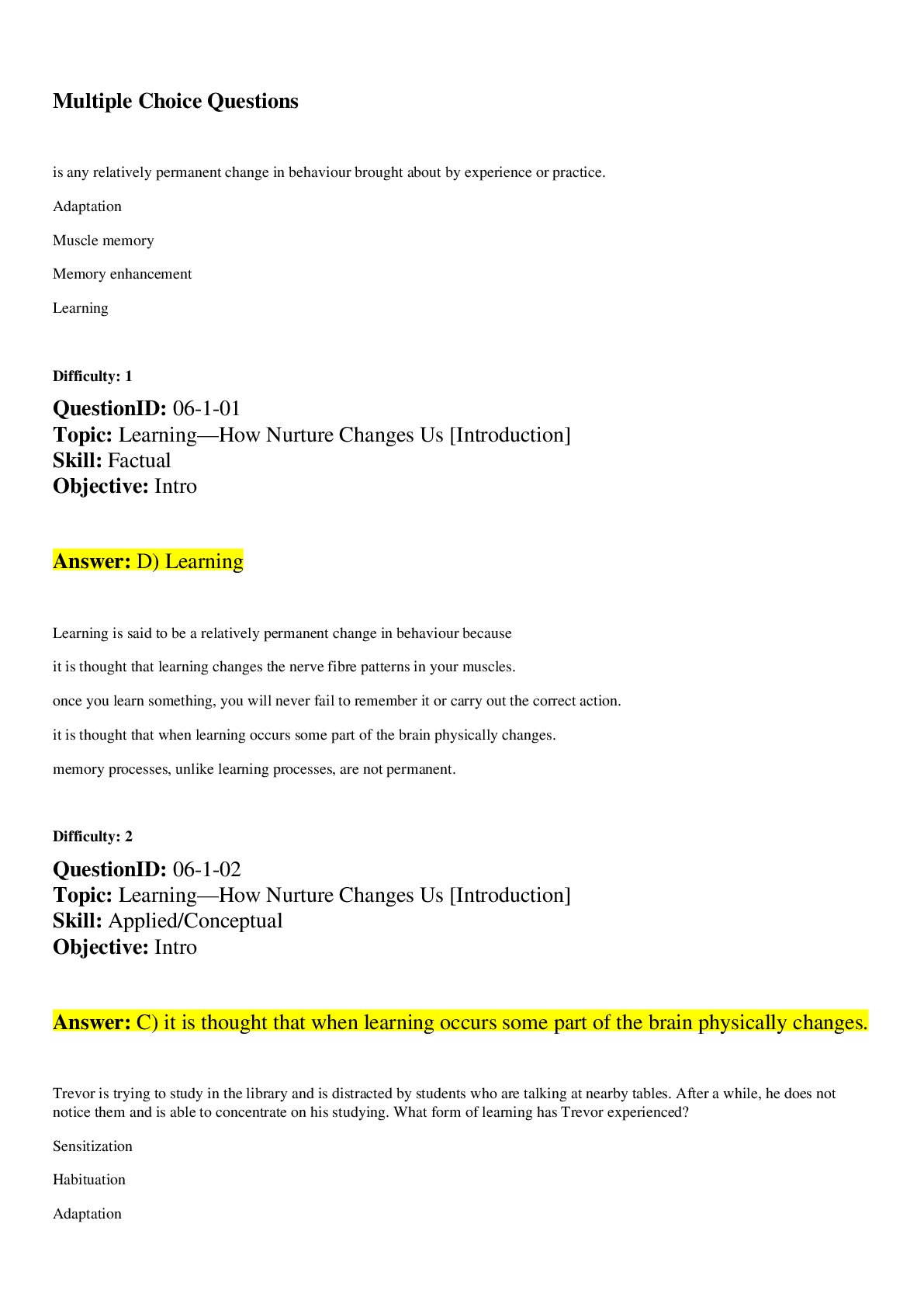
Reviews( 0 )
Document information
Connected school, study & course
About the document
Uploaded On
Sep 26, 2021
Number of pages
17
Written in
Additional information
This document has been written for:
Uploaded
Sep 26, 2021
Downloads
0
Views
25

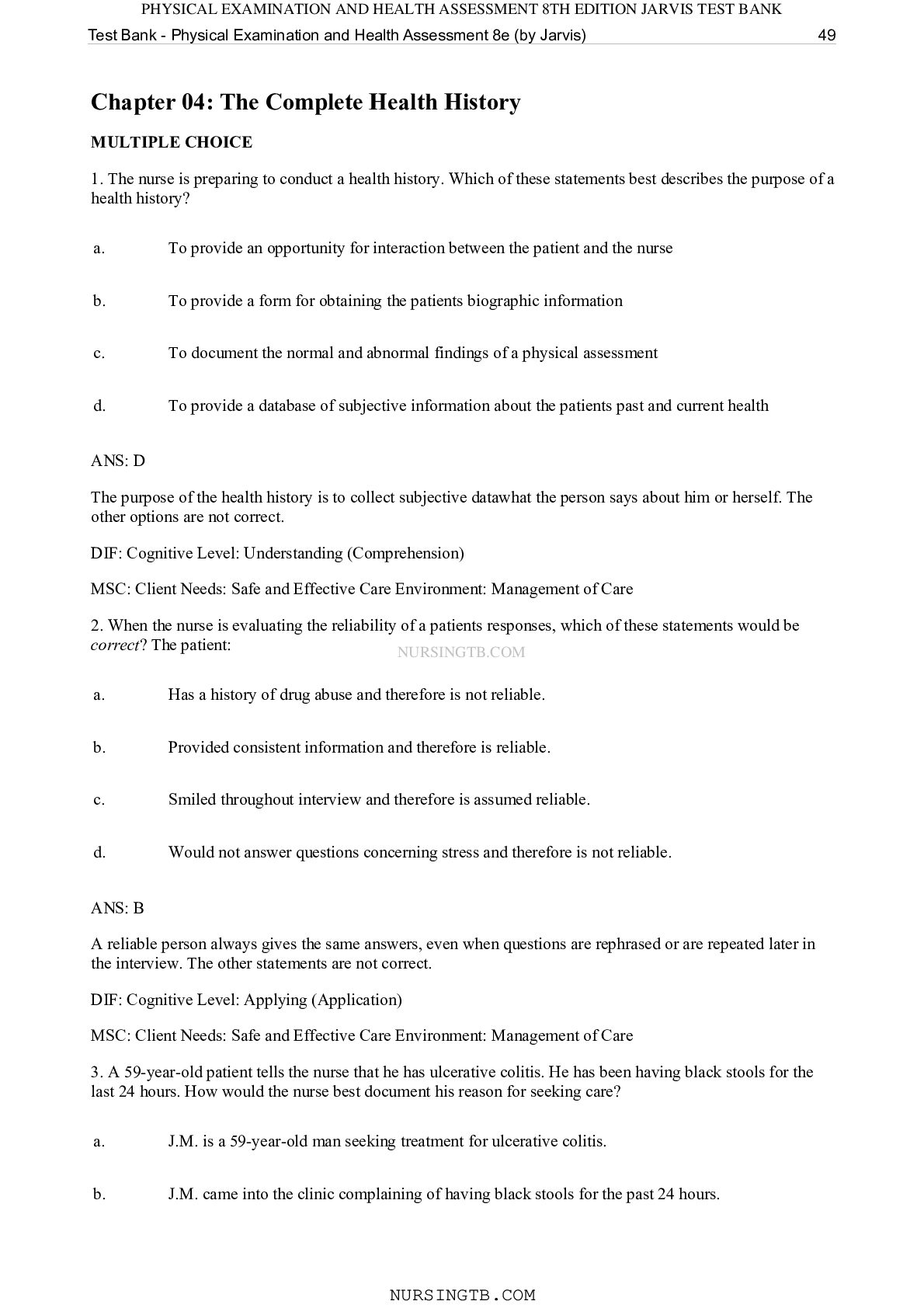









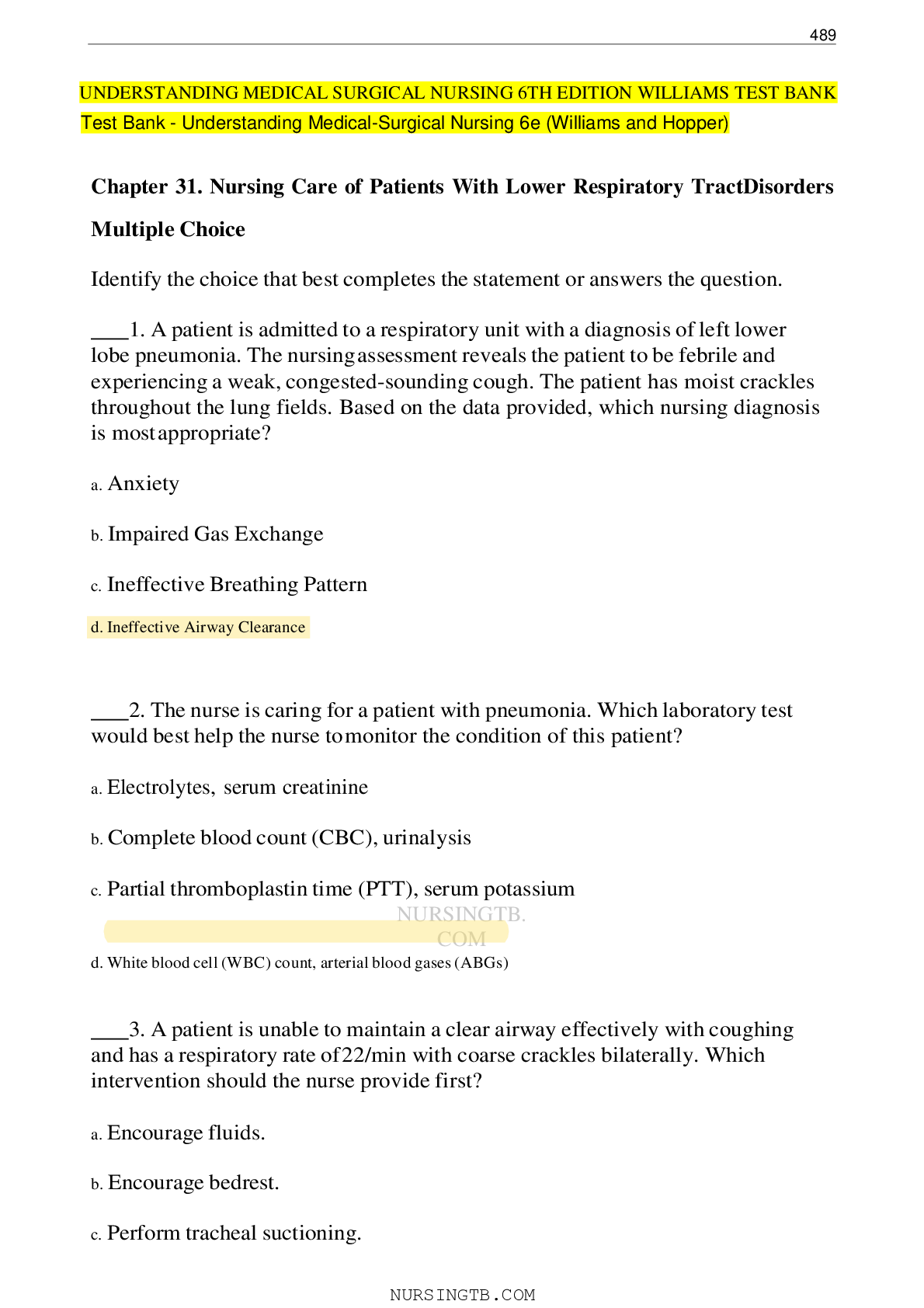

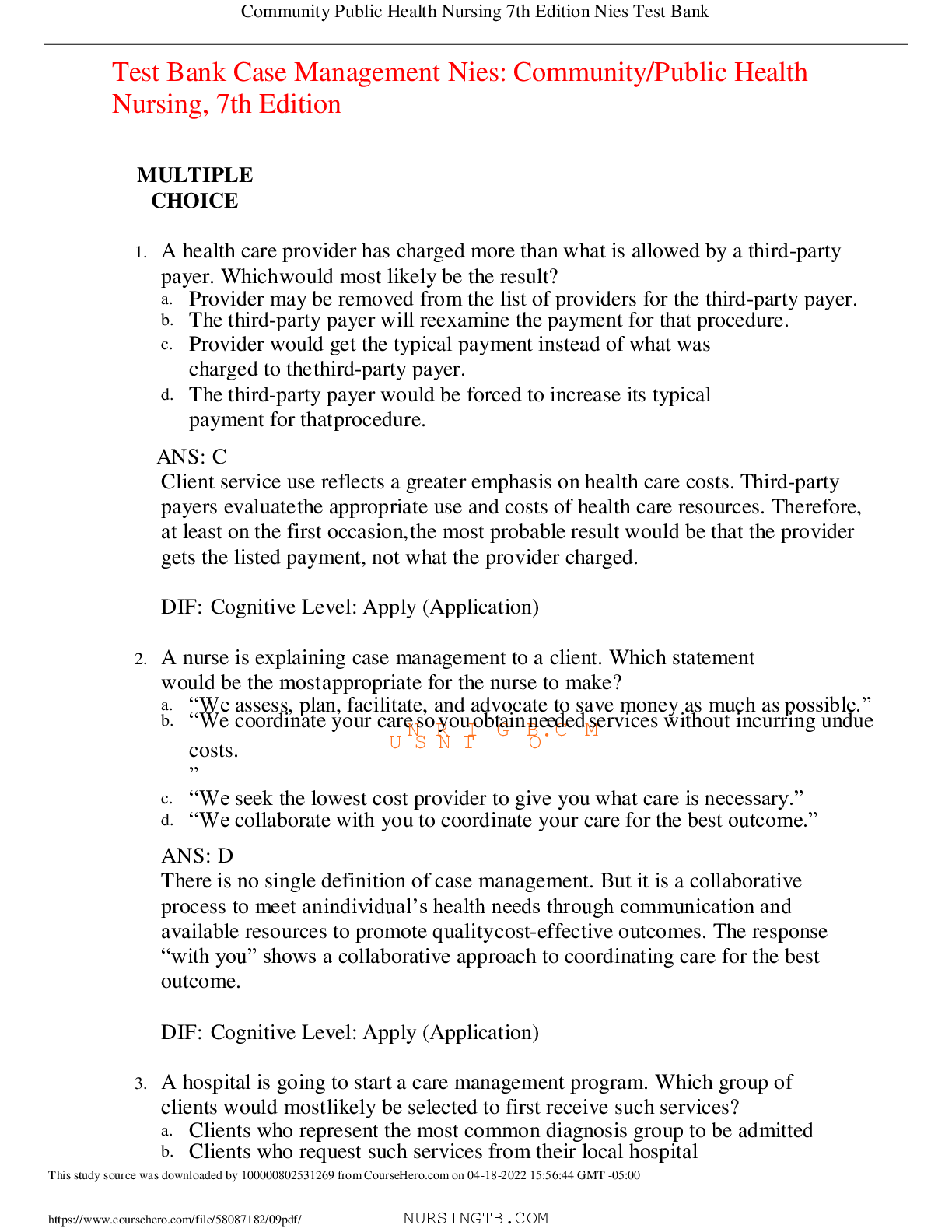

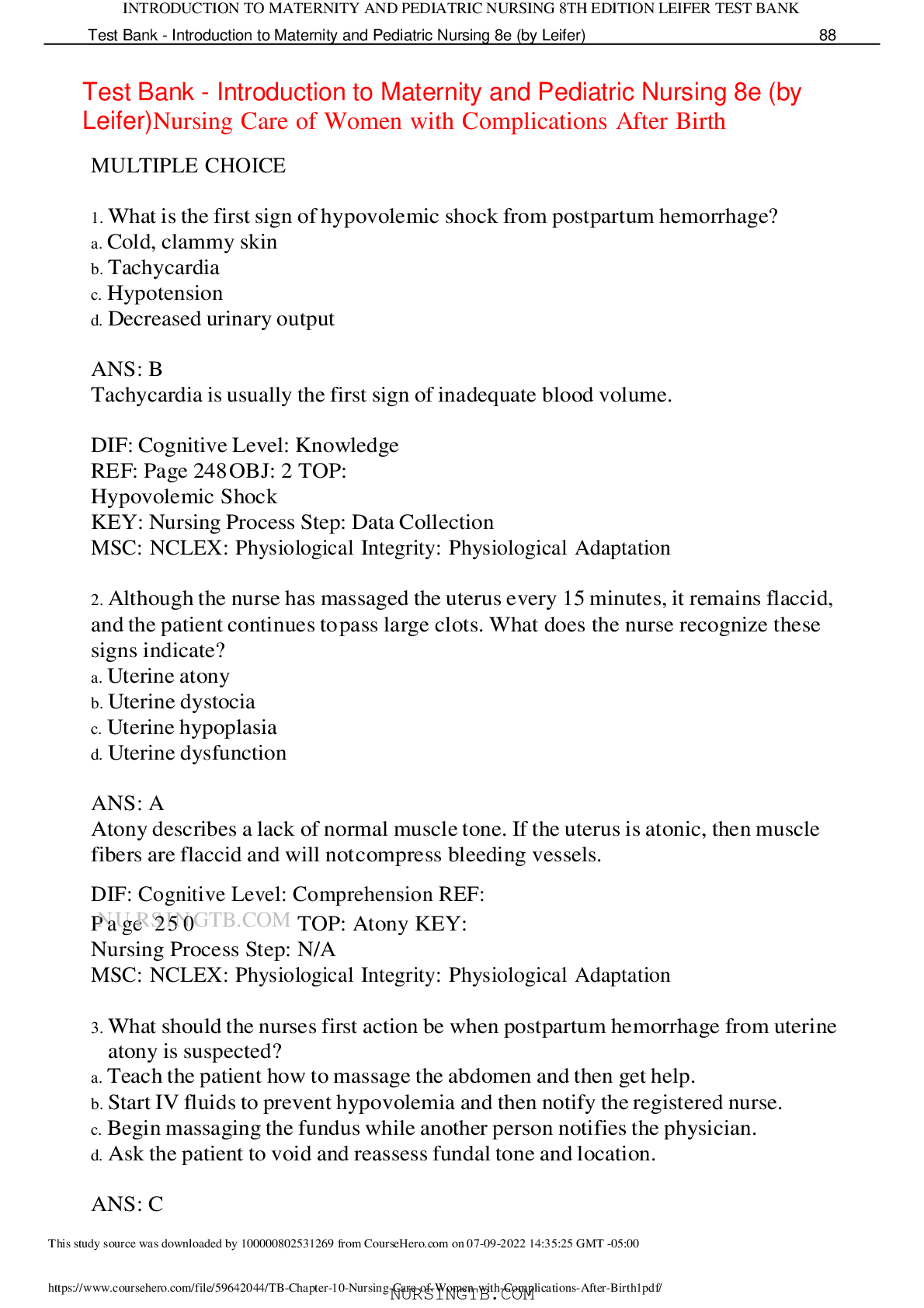

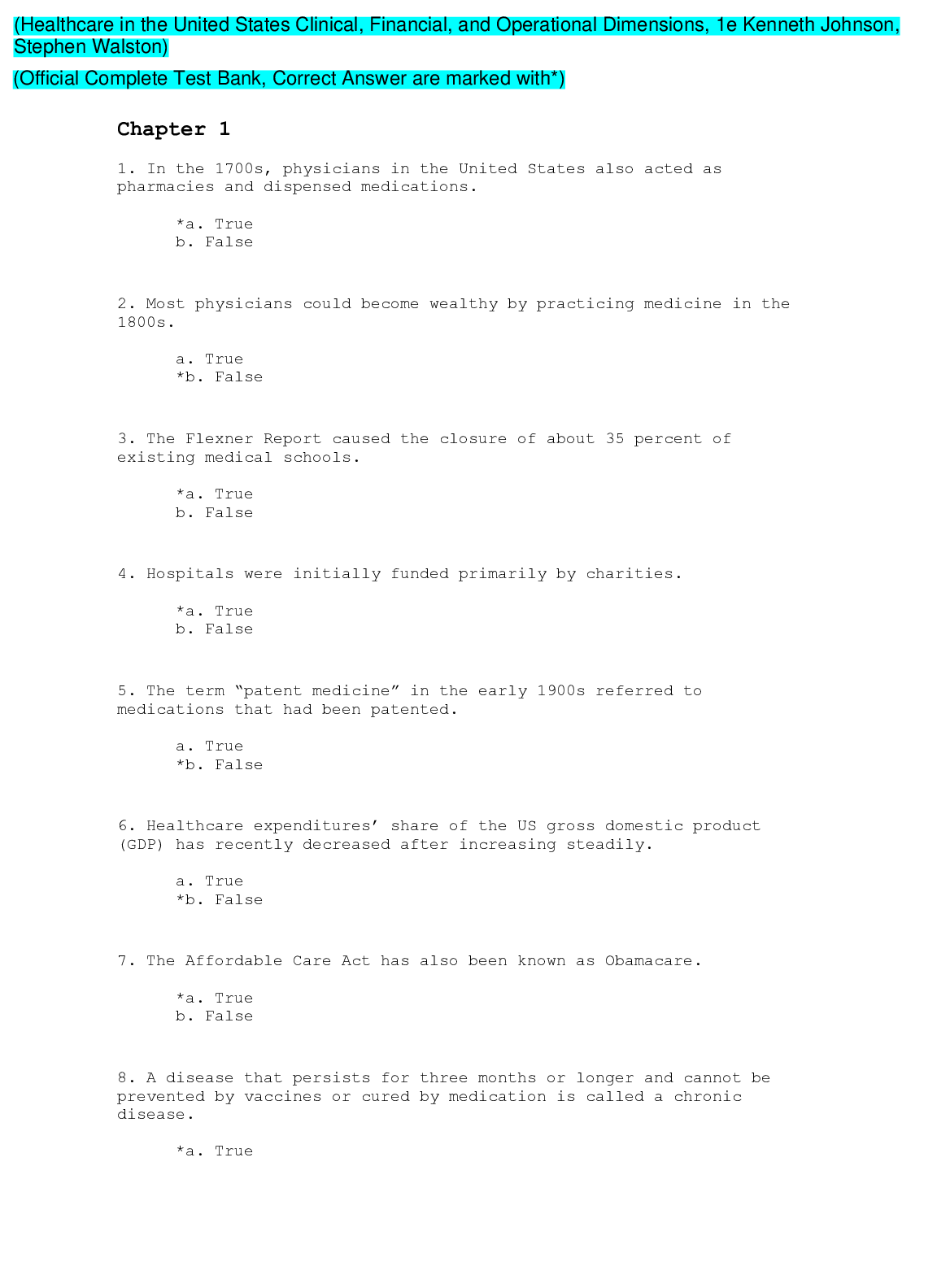
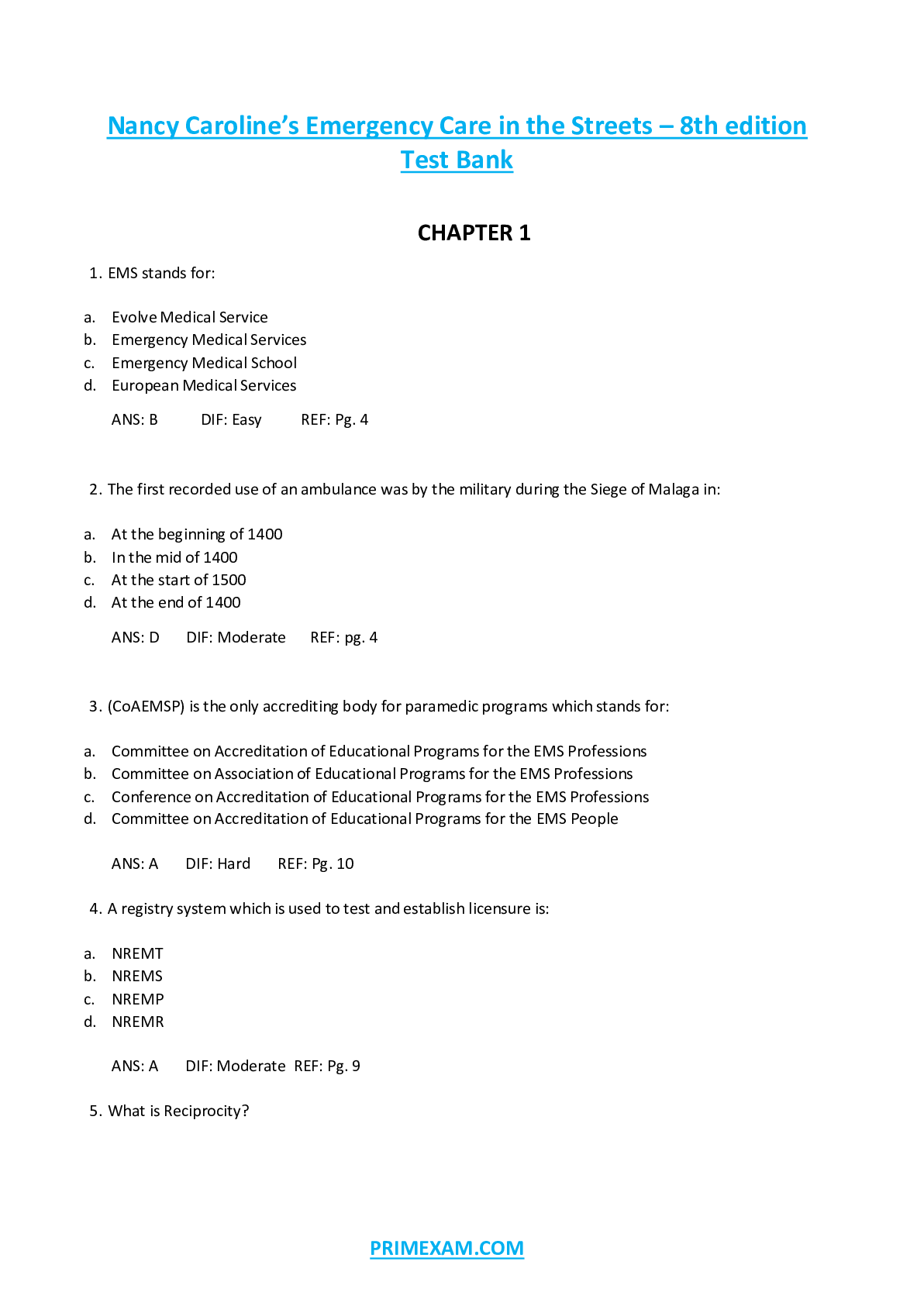
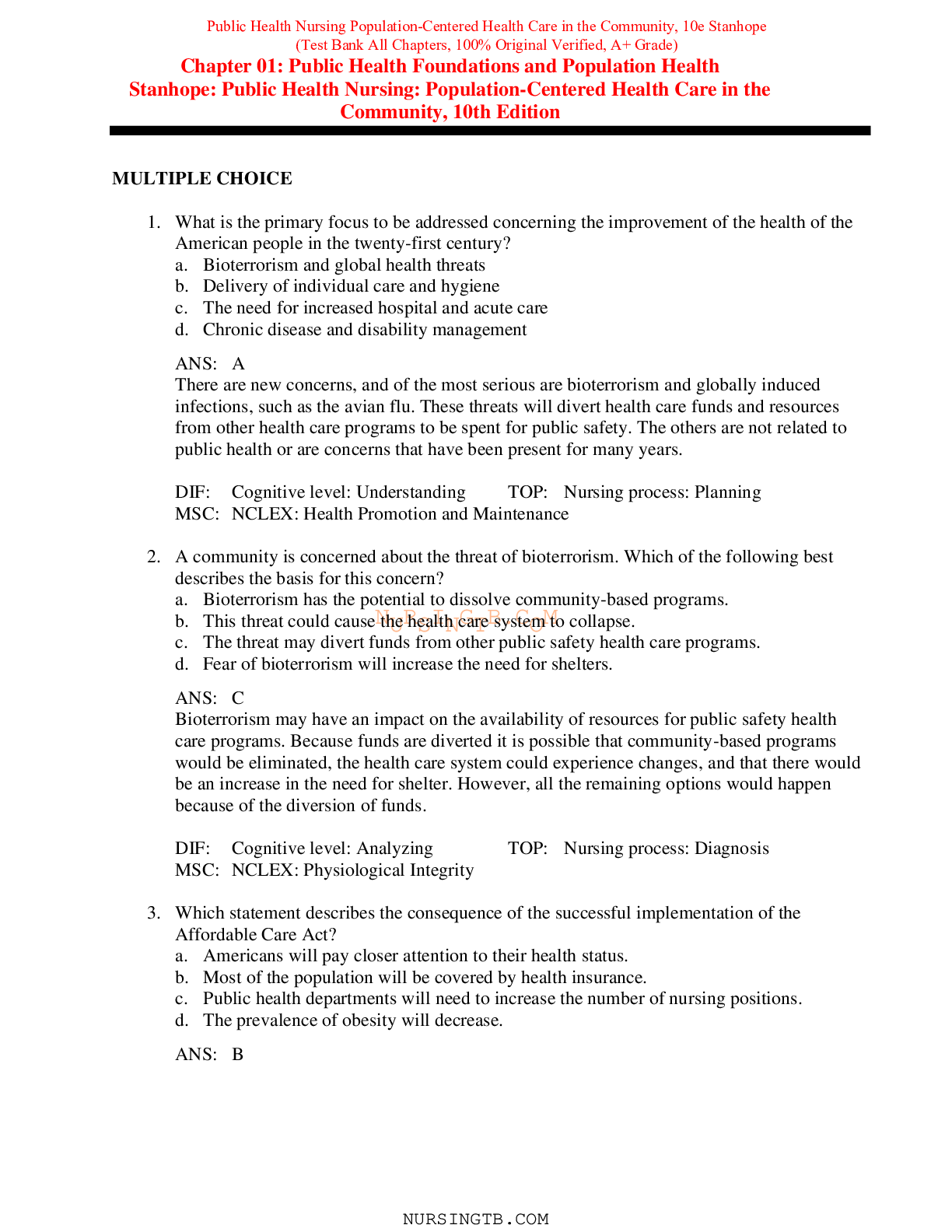


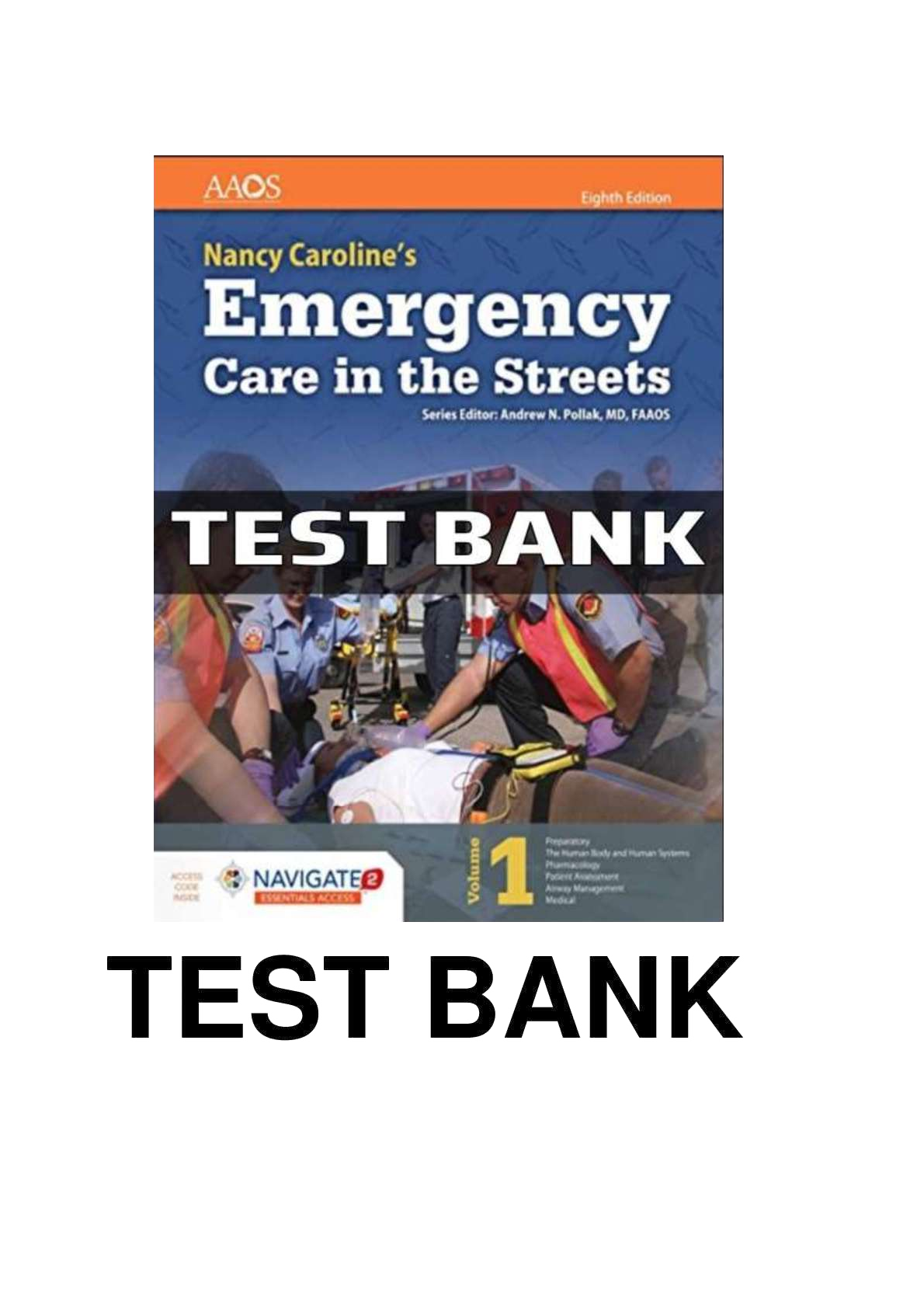
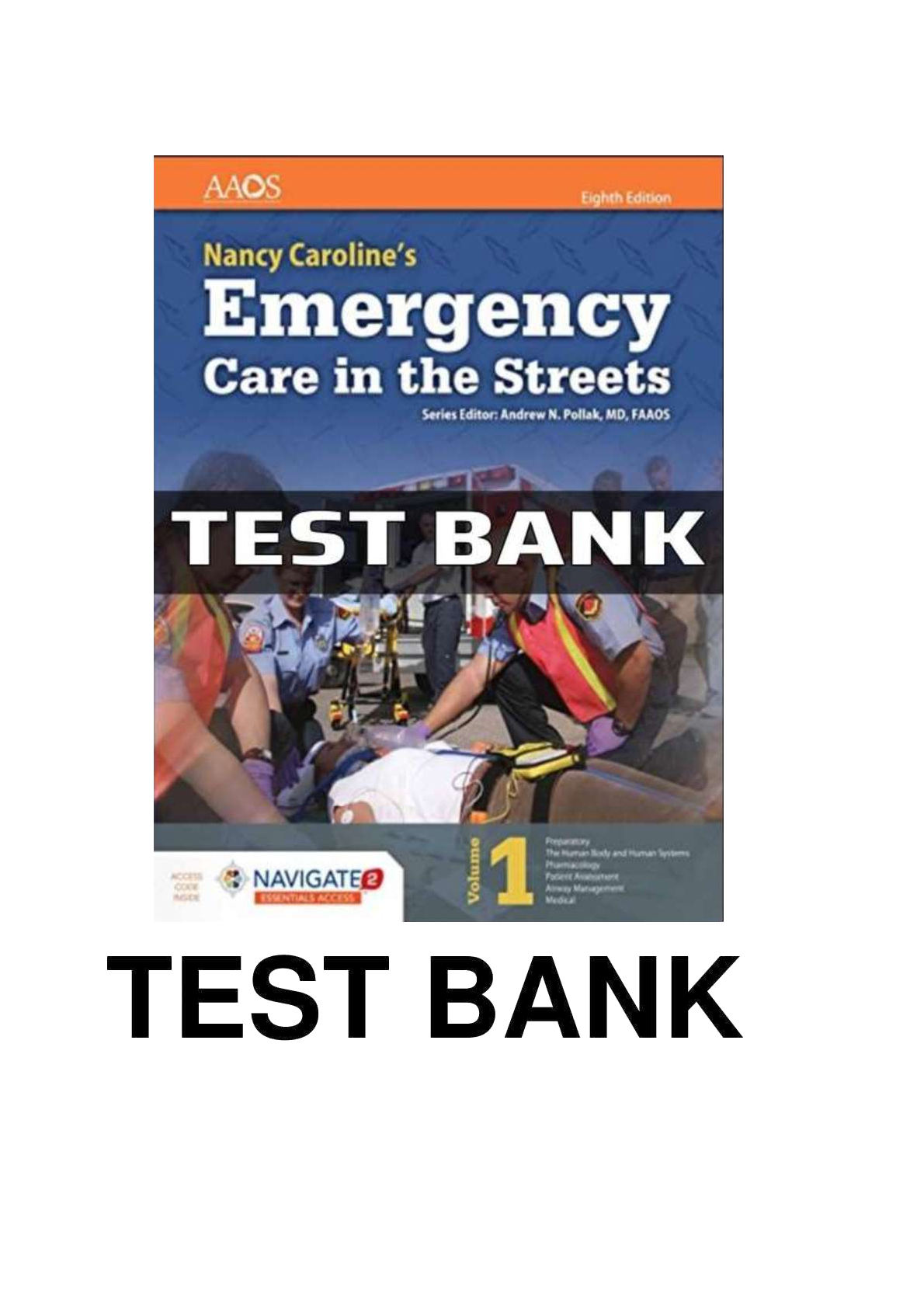
.png)
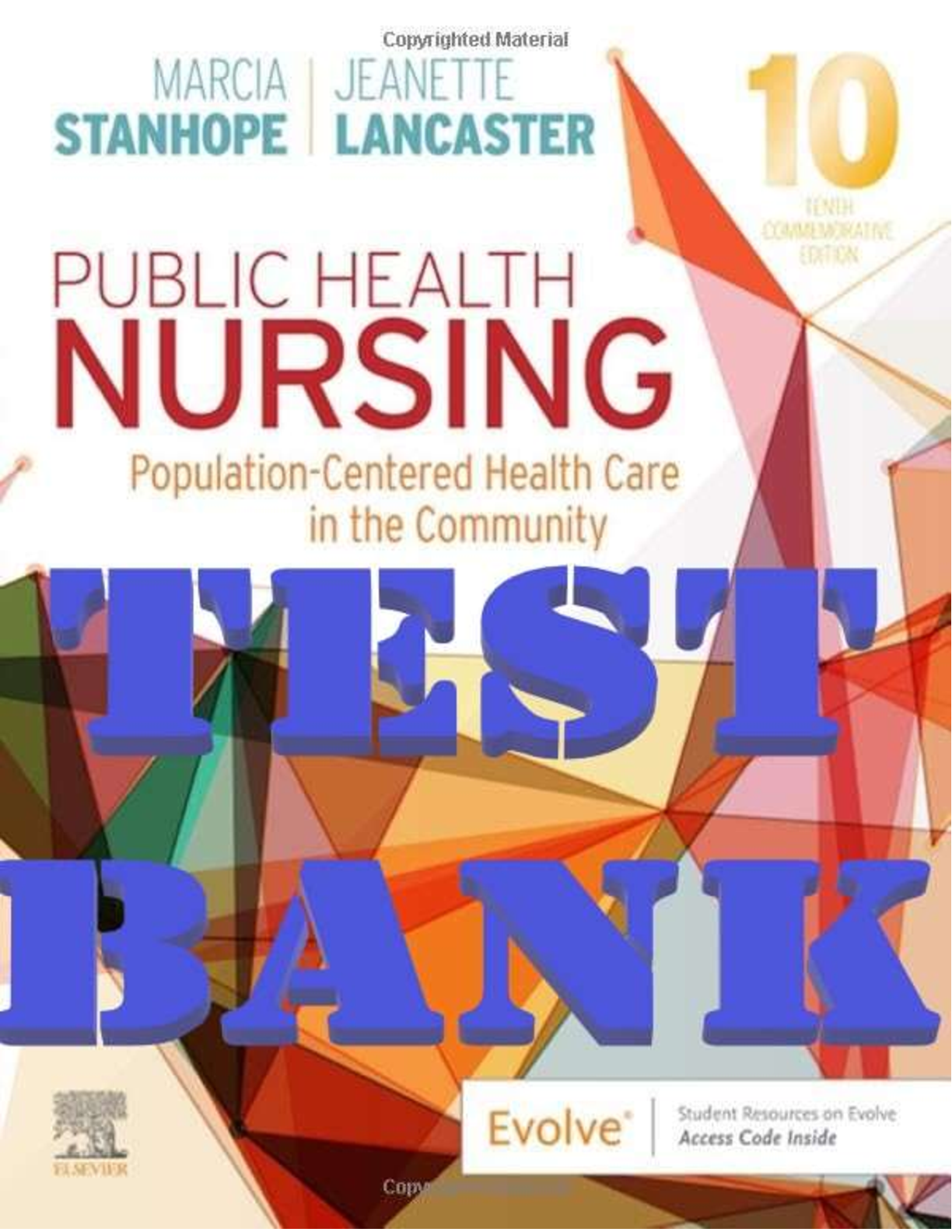
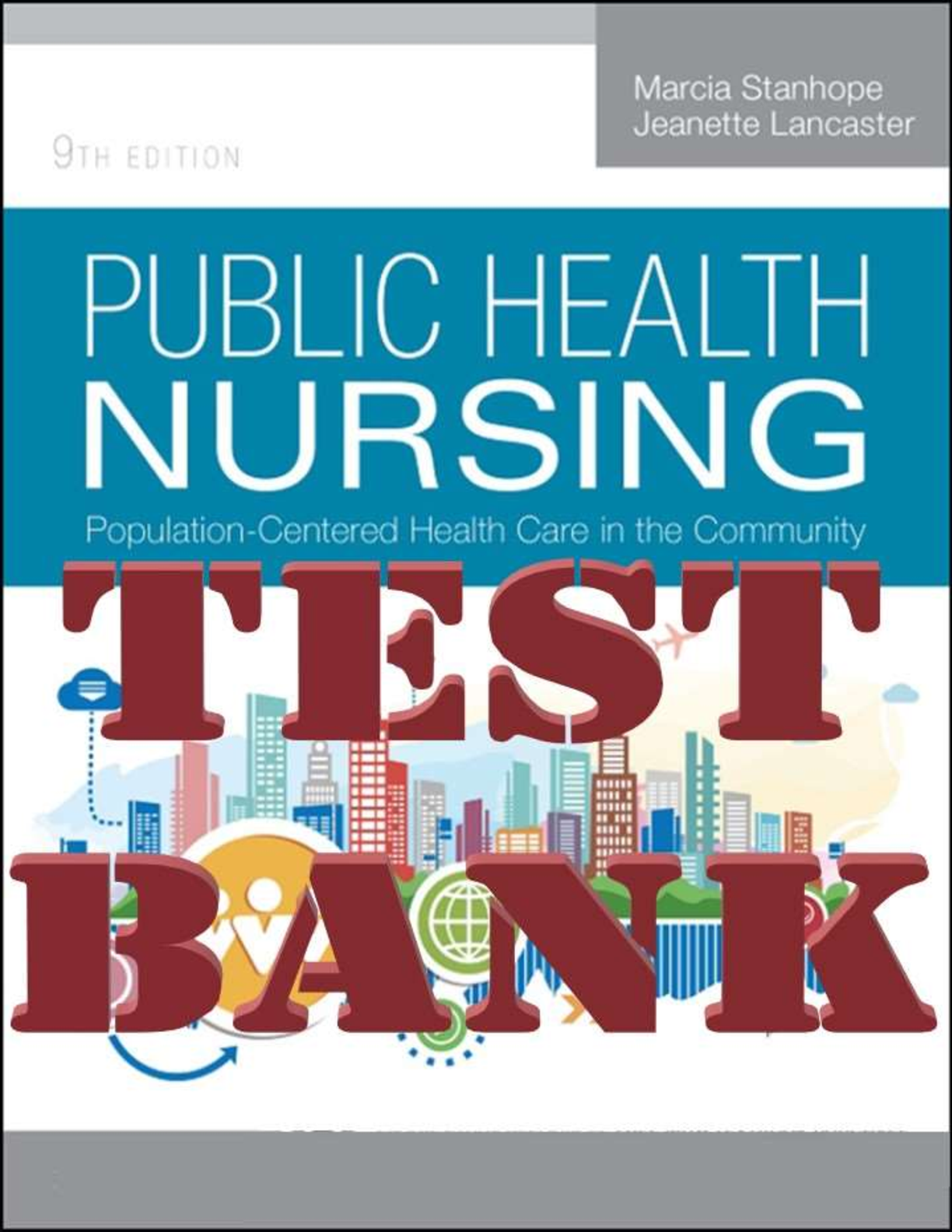

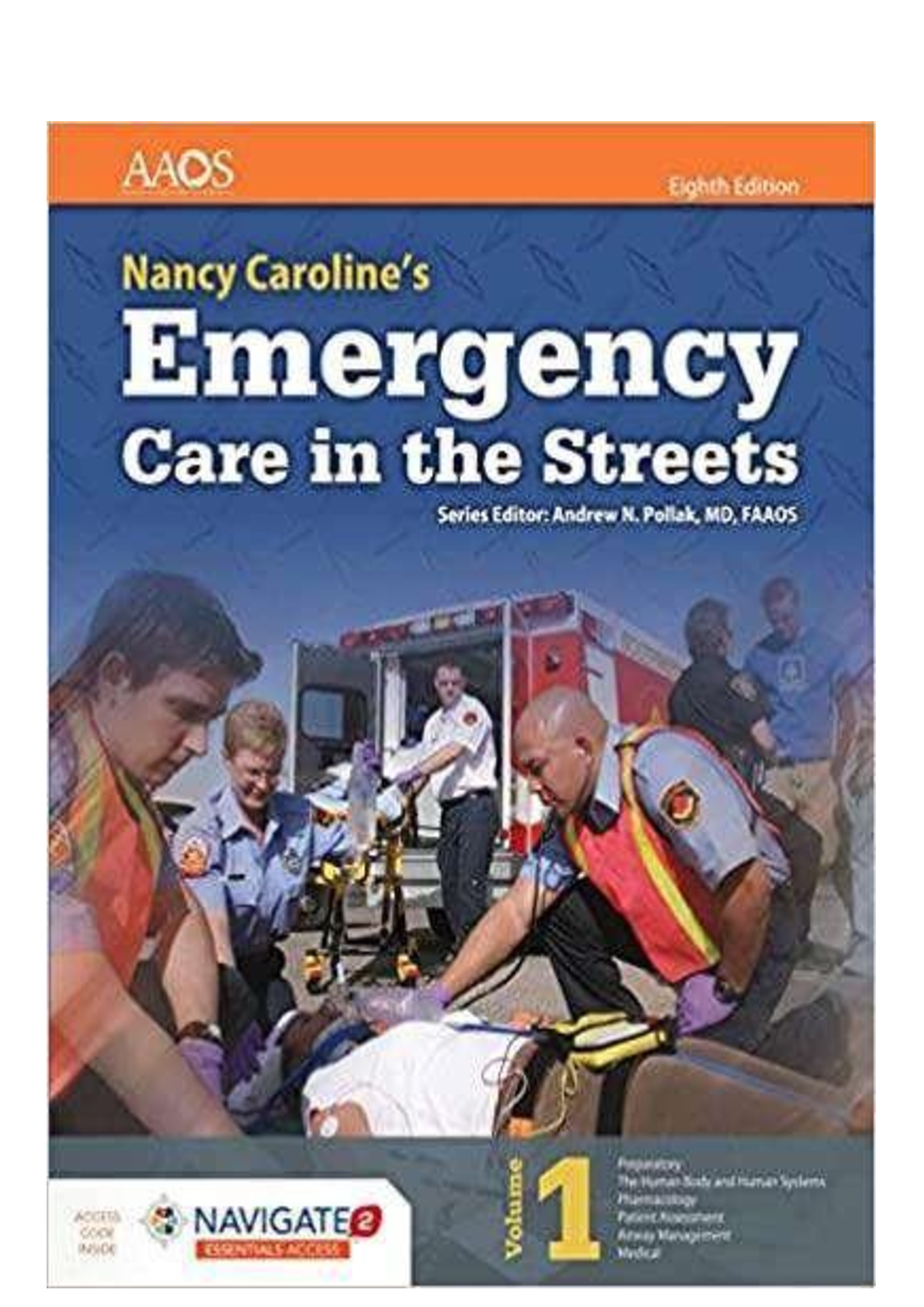
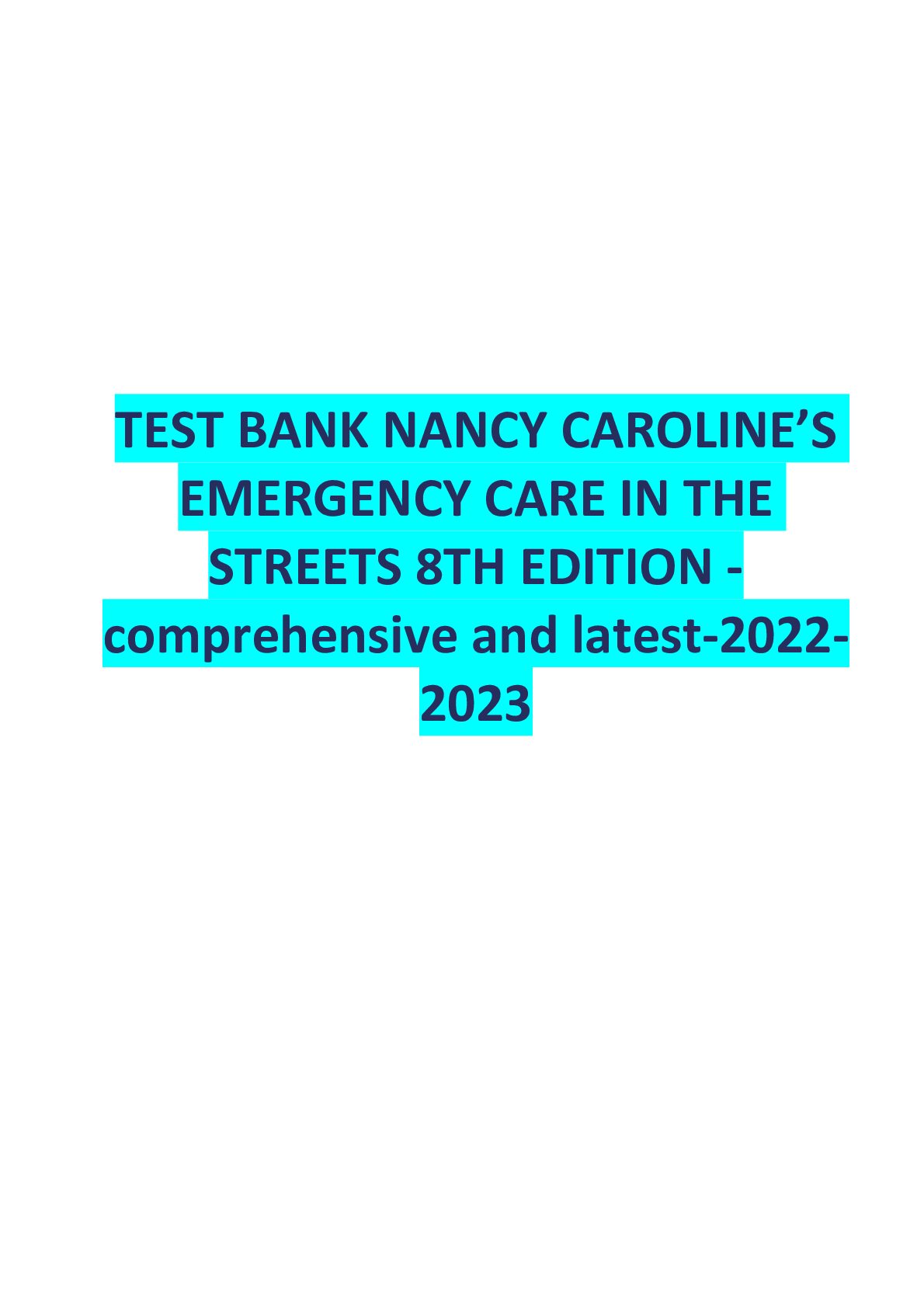
_compressed.png)

 (2).png)

